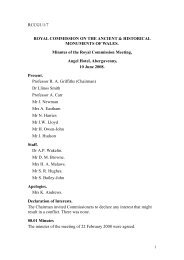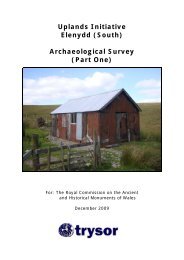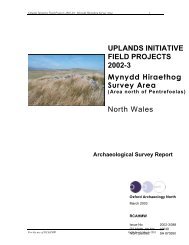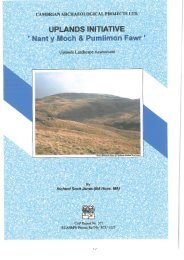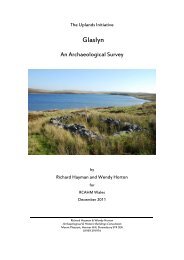Mynydd Llangynidr, Brecknockshire - Royal Commission on the ...
Mynydd Llangynidr, Brecknockshire - Royal Commission on the ...
Mynydd Llangynidr, Brecknockshire - Royal Commission on the ...
You also want an ePaper? Increase the reach of your titles
YUMPU automatically turns print PDFs into web optimized ePapers that Google loves.
<str<strong>on</strong>g>Mynydd</str<strong>on</strong>g> <str<strong>on</strong>g>Llangynidr</str<strong>on</strong>g> Upland Survey<br />
UIP081 Report Versi<strong>on</strong>: Final<br />
Produced for RCAHMW<br />
O<strong>the</strong>r uplands research <strong>the</strong>mes<br />
Agri-Industrial settlement patterns in c<strong>on</strong>texts where farming and industrial activity coalesce<br />
6.20 Similarities in c<strong>on</strong>structi<strong>on</strong> of some hearths and ovens inside domestic shepherds’ huts<br />
were shared with some of <strong>the</strong> lime kilns. Some limekilns were also very close to domestic<br />
settlement activity. This may suggest that small agricultural communities were involved in <strong>the</strong><br />
lime producing industry fur<strong>the</strong>r up <strong>the</strong> slopes and that <strong>the</strong>y may have produced some lime for use<br />
within <strong>the</strong>ir own community.<br />
The relati<strong>on</strong>ship of sites to woodland, where it exists and to identified deposits of peat and<br />
areas of peat extracti<strong>on</strong> or drainage<br />
6.21 The <strong>on</strong>ly areas of woodland in <strong>the</strong> survey area were <strong>on</strong> <strong>the</strong> boundaries of <strong>the</strong> area.<br />
6.22 The area of woodland was not associated with peat extracti<strong>on</strong> in <strong>the</strong> area. Peat is<br />
widespread <strong>on</strong> <strong>the</strong> top of <strong>the</strong> survey area, but no examples of peat cutting were found during <strong>the</strong><br />
survey.<br />
Transport networks of all periods in relati<strong>on</strong> to <strong>the</strong> upland areas and <strong>the</strong> inter-regi<strong>on</strong>al<br />
implicati<strong>on</strong>s of <strong>the</strong>se, in particular extensive remains of upland trackways and early systems of<br />
roads and tramways with <strong>the</strong>ir associated infrastructure<br />
6.23 Most of <strong>the</strong> tracks in <strong>the</strong> survey area are difficult to date and were often still in use until<br />
recently to access quarries or by modern walkers. However, due to <strong>the</strong> wear <strong>on</strong> some of <strong>the</strong><br />
tracks and <strong>the</strong> existence of a number of possible prehistoric cairns al<strong>on</strong>g <strong>the</strong> route, it is likely that<br />
some of <strong>the</strong> tracks have been used over a l<strong>on</strong>g period of time and may date back as far as <strong>the</strong><br />
prehistoric period. Some of <strong>the</strong> quarry tracks could date to <strong>the</strong> medieval or post-medieval period,<br />
but have been updated and maintained for more recent use.<br />
6.24 Some tracks were probably established for accessing shooting butts, as <strong>the</strong>se are a<br />
comm<strong>on</strong> feature particularly <strong>on</strong> <strong>the</strong> eastern side of <strong>the</strong> area where <strong>the</strong>re is copious outcropping<br />
rock and easy access to <strong>the</strong> relatively flat areas. These might account for some of <strong>the</strong> more<br />
ephemeral track.<br />
6.25 The tracks and paths that run al<strong>on</strong>g <strong>the</strong> top of both ridges are likely to have been in use<br />
since antiquity. Prehistoric cairns and mounds are located <strong>on</strong> <strong>the</strong> ridges and peaks, but <strong>the</strong> paths<br />
are also denoted by marker cairns (which are probably of various dates). No boundary st<strong>on</strong>es<br />
marking track were located during <strong>the</strong> survey, with <strong>the</strong> abundance of loose limest<strong>on</strong>e scree<br />
probably making small cairns an easier way to mark <strong>the</strong> tracks.<br />
Page 17<br />
\\Harappa\projects\UIP081 <str<strong>on</strong>g>Mynydd</str<strong>on</strong>g> <str<strong>on</strong>g>Llangynidr</str<strong>on</strong>g>\Reporting\Draft Final\AP UIP081 <str<strong>on</strong>g>Mynydd</str<strong>on</strong>g> <str<strong>on</strong>g>Llangynidr</str<strong>on</strong>g> report<br />
(Draft Final).doc<br />
Copyright ArchaeoPhysica Ltd. 10/02/2009




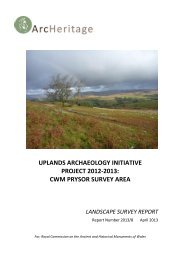
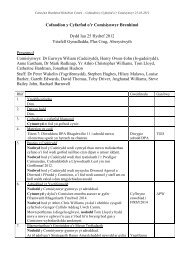
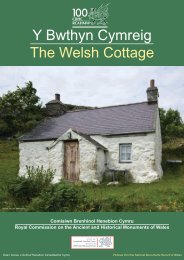

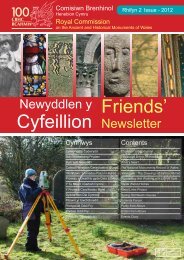
![The Source of the Usk Walk [2012 PDF]](https://img.yumpu.com/49285699/1/190x245/the-source-of-the-usk-walk-2012-pdf.jpg?quality=85)


